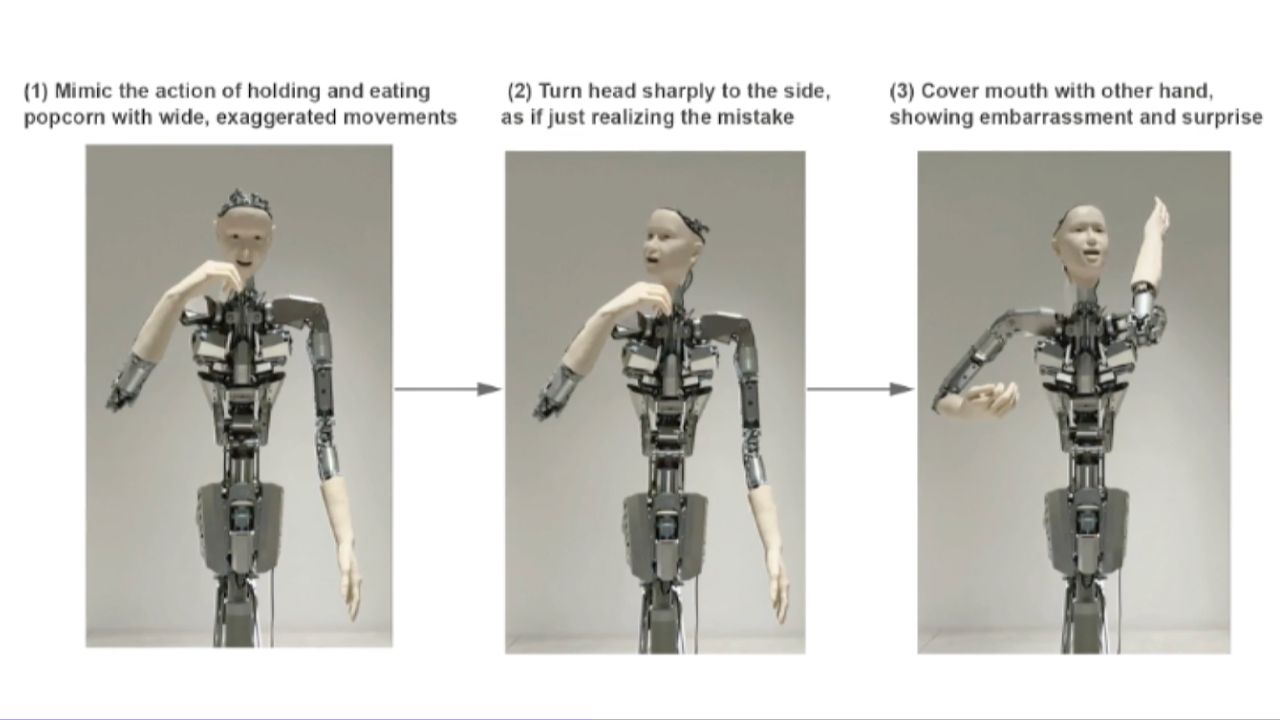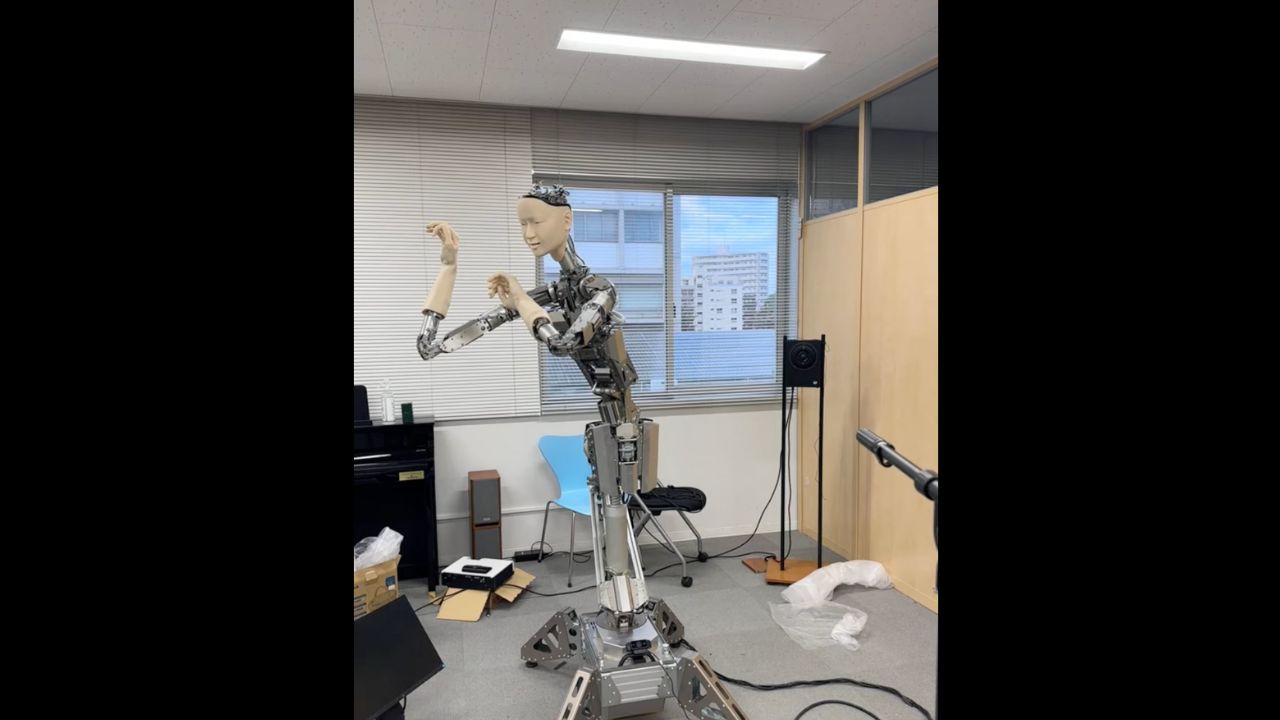Imagine what it would be like to have a robot friend that can do things like take selfies, toss a ball, eat popcorn, and play air guitar? Well, you might not have to wait too long, because researchers at the University of Tokyo have created a robot that can do all that and more, thanks to the power of GPT-4, the latest and most advanced large language model (LLM) in the world.

What is the Alter3 humanoid robot and how does it work?
Alter3 is a humanoid robot that was first introduced in 2016 as a platform for exploring the concept of life in artificial systems. It has a realistic appearance and can move its upper body, head, and facial muscles with 43 axes controlled by air actuators. It also has a camera in each eye that allows it to see and interact with humans and the environment.

Credit: University of Tokyo

Credit: University of Tokyo
But what makes Alter3 really special is that it can now use GPT-4, a deep learning model that can generate natural language texts from any given prompt, to control its movements and behaviors. This means that instead of having to program every single action for the robot, the researchers can simply give it verbal instructions and let GPT-4 generate the corresponding Python code that runs the Android engine.
For example, to make Alter3 take a selfie, the researchers can say something like:
Create a big, joyful smile and widen your eyes to show excitement. Swiftly turn the upper body slightly to the left, adopting a dynamic posture. Raise the right hand high, simulating a phone. Flex the right elbow, bringing the phone closer to the face. Tilt the head slightly to the right, giving a playful vibe.
And GPT-4 will produce the code that makes Alter3 do exactly that.

Credit: University of Tokyo
MORE: HUMANOID ROBOTS ARE NOW DOING THE WORK OF HUMANS IN A SPANX WAREHOUSE
What can the Alter3 humanoid robot do with GPT-4?
The researchers have tested Alter3 with GPT-4 in various scenarios, such as tossing a ball, eating popcorn, and playing air guitar. They have also experimented with different types of feedback, such as linguistic, visual, and emotional, to improve the robot’s performance and adaptability.

Credit: University of Tokyo
One of the most interesting aspects of Alter3’s behavior is that it can learn from its own memory and from human responses. For instance, if the robot does something that makes a human laugh or smile, it will remember that and try to repeat it in the future. This is similar to how newborn babies imitate their parents’ expressions and gestures.

Credit: University of Tokyo
MORE: THE NEXT GENERATION OF TESLA’S HUMANOID ROBOT MAKES ITS DEBUT
The researchers have also added some humor and personality to Alter3’s actions. In one case, the robot pretends to eat a bag of popcorn, only to realize that it belongs to the person sitting next to it. It then shows a surprised and embarrassed expression and apologizes with its arms.

Credit: University of Tokyo
Why is this humanoid robot AI important and what are the implications?
The research team behind Alter3 believes that this is a breakthrough in the field of robotics and artificial intelligence, as it shows how large language models can be used to bridge the gap between natural language and robot control. This opens up new possibilities for human-robot collaboration and communication, as well as for creating more intelligent, adaptable, and personable robotic entities.

Credit: University of Tokyo
MORE: HOW THIS ROBOT HELPS YOU PROTECT AND CONNECT YOUR HOME
The paper, titled “From Text to Motion: Grounding GPT-4 in a Humanoid Robot ‘Alter3’,” was written by Takahide Yoshida, Atsushi Masumori, and Takashi Ikegami, and is available on the preprint server arXiv. The authors hope that their work will inspire more research and development in this direction, and that one day, we might be able to have robot friends that can understand us and share our interests and emotions.

Kurt’s key takeaways
Alter3 is an example of how natural language processing and robotics can work together to create pretty incredible interactions. By using GPT-4, the robot can perform a variety of tasks and behaviors based on verbal commands, without requiring extensive programming or manual control. This also allows the robot to learn from its own experience and from human feedback, and to express some humor and personality. Alter3 demonstrates the potential of large language models to improve the field of robotics and artificial intelligence, and to bring us closer to having robot friends that can relate to us and entertain us.
What do you think of Alter3 and its abilities? Would you like to have a robot like that in your life? Let us know in the comments below.
FOR MORE OF MY SECURITY ALERTS, SUBSCRIBE TO MY FREE CYBERGUY REPORT NEWSLETTER HERE
🛍️ SHOPPING GUIDES:
KIDS | MEN | WOMEN | TEENS | PETS |
FOR THOSE WHO LOVE:
COOKING | COFFEE | TOOLS | TRAVEL | WINE |
DEVICES:
LAPTOPS | TABLETS | PRINTERS | DESKTOPS | MONITORS | EARBUDS | HEADPHONES | KINDLES | SOUNDBARS | KINDLES | DRONES |
ACCESSORIES:
CAR | KITCHEN | LAPTOP | KEYBOARDS | PHONE | TRAVEL | KEEP IT COZY |
PERSONAL GIFTS:
PHOTOBOOKS | DIGITAL PHOTO FRAMES |
SECURITY
ANTIVIRUS | VPN | SECURE EMAIL |
CAN'T GO WRONG WITH THESE:



